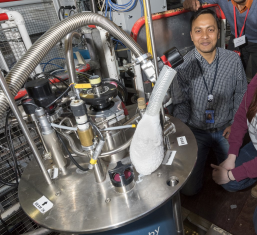Speaker
Description
The hole-doped organic superconductor kappa-(ET)4Hg3-dBr8, (k-HgBr), where d=11% and ET=bis(ethylenedithio)tetrathiafulvalene, has been the key to bridge the knowledge gap between half-filled organics and doped cuprate systems. Nonetheless, the isotropic triangular lattice of ET dimers of k-HgBr, organics, unlike the square lattice in cuprates, is suspectedly responsible for its provides extensive geometrically control through nearest, t, and next-nearest, t', transfer integrals between sites. In k-HgBr the temperature dependence of susceptibility which is well scaled with the organic spin liquid insulator k-(ET)2Cu(CN)3. follows isotropic triangular lattice model t ~ t', i. e., candidate of a doped Mott quantum spin liquid. However, both k-HgBr and cuprate superconductors have a wide region at high-temperature and high-pressure corresponding to a strange metallic state where resistivity exhibits a linear temperature dependence which is a non-Fermi-liquid (FL) behavior. In k-HgBr this non-FL region gradually changed to FL state by pressure [1] like the change of metallic state from optimal to overdoped cuprates. The 13C-NMR and heat capacity study suggested that the enhanced antiferromagnetic fluctuations towards low-temperature originates the non-FL k-HgBr [2]. This evidence may locate superconducting k-HgBr nearby quantum critical point (QCP) in between FL and localized states, where in its non-FL state the incoherent conductivity was observed [1,3]. Our zero-field muSR experiment showed the relaxation rate from temperature around 10 K down to 0.3 K is temperature-independent. This is a high possibility of the superconducting state that preserved time-reversal symmetry [4]. Furthermore, we will present the result of temperature dependence of penetration depth from transverse field muSR measurement, showing a peculiar estimation of strong coupling superconductivity with small superfluid density. We discuss the comparation with other organic superconductors which showed a typical and a deviation from traditional d-wave symmetry [5].
References
[1] H. Taniguchi, et al., J. Phys. Soc. Jpn. 11, 113709 (2007)
[2] Y. Eto, et al., Phys. Rev. B 81, 212503 (2010)
[3] H. Oike, et al., Nat. Commun. 8, 756 (2017)
[4] D. P. Sari, et al., J. Phys.: Conf. Ser. 2462, 012061 (2023)
[5] D. P. Sari, et al., Phys Rev B. 104, 224506 (2021)

